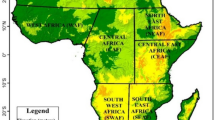Abstract
There is growing evidence that the role internal variability plays in our confidence in future climate projections has been under-appreciated in past assessments of model projections for the coming decades. In light of this, a 15 member ensemble has been produced to complement the existing 30 member “Large Ensemble” conducted with the Community Earth System Model (CESM). In contrast to the Large Ensemble, which explored the variability in RCP8.5, our new ensemble uses the moderate mitigation scenario represented by RCP4.5. By comparing outputs from these two ensembles, we assess at what point in the future the climates conditioned on the two scenarios will begin to significantly diverge. We find in general that while internal variability is a significant component of uncertainty for periods before 2050, there is evidence of a significantly increased risk of extreme warm events in some regions as early as 2030 in RCP8.5 relative to RCP4.5. Furthermore, the period 2061-2080 sees largely separate joint distributions of annual mean temperature and precipitation in most regions for the two ensembles. Hence, in the CESM’s representation of the Earth System for the latter portion of the 21st century, the range of climatic states which might be expected in the RCP8.5 scenario is significantly and detectably further removed from today’s climate state than the RCP4.5 scenario even in the presence of internal variability.







Similar content being viewed by others
References
Anderson GB, Oleson K, Jones B, Peng RD (in review) Climatic Change
Arnell NW, Lowe J, Brown S, Gosling S, Gottschalk P, Hinkel J, Lloyd-Hughes B, Nicholls R, Osborn T, Osborne TM, et al. (2013) Nat Clim Chang 3(5):512
Branstator G, Teng H, Meehl GA, Kimoto M, Knight JR, Latif M, Rosati A (2012) J Clim 25(6):1827
Caesar J, Lowe JA (2012) J Geophys Res Atmos 117(D15):1984–2012
Change C (2014) Cambridge, United Kingdom and New York, USA
Clarke L, Edmonds J, Jacoby H, Pitcher H, Reilly J, Richels R (2007) US Government Printing Office, Washington DC
Deser C, Phillips A, Bourdette V, Teng H (2012) Clim Dyn 38(3-4):527
Fischer E, Beyerle U, Knutti R (2013) Nat Clim Chang 3(12):1033
Giorgi F, Francisco R (2000) Clim Dynam 16(2-3):169
Hansen J, Sato M, Ruedy R, Kharecha P, Lacis A, Miller R, Nazarenko L, Lo K, Schmidt G, Russell G, et al. (2007) Atmos Chem Phys 7(9):2287
Hurrell JW, Holland MM, Gent PR, Ghan S, Kay JE, Kushner P, Lamarque JF, Large WG, Lawrence D, Lindsay K, et al. (2013) Bull Am Meteorol Soc 94(9):1339
Kay J, Deser C, Phillips A, Mai A, Hannay C, Strand G, Arblaster J, Bates S, Danabasoglu G, Edwards J, et al. (2014) Bull Am Meteorol Soc
Lehner F, Deser C, Sanderson B (submitted) Climatic Change
Lin L, Gettelman A, Fu Q, Xu Y (submitted) Climatic Change
Lombardozzi D, Bonan GB, Nychka DW (2014) Nat Clim Chang 4(9):796
Lorenz EN (1969) Tellus 21(3):289. doi:10.1111/j.2153-3490.1969.tb00444.x
Mahlstein I, Knutti R, Solomon S, Portmann R (2011) Environ Res Lett 6(3):034009
Masui T, Matsumoto K, Hijioka Y, Kinoshita T, Nozawa T, Ishiwatari S, Kato E, Shukla P, Yamagata Y, Kainuma M (2011) Climatic Change 109(1–2):59
Meehl GA, Washington WM, Arblaster JM, Hu A, Teng H, Kay JE, Gettelman A, Lawrence DM, Sanderson BM, Strand WG (2013) J Clim 26 (17):6287
Messner S, Schrattenholzer L (2000) Energy 25(3):267
Oleson K, Anderson G, Jones B, McGinnis S, Sanderson B (2015) Avoided climate impacts of urban and rural heat and cold waves over the US using large climate model ensembles for RCP8.5 and RCP4.5. Climatic Change. doi:10.1007/s10584-015-1504-1
O’Neill B, Gettelman A (in preparation)
Perkins SE, Fischer EM (2013) Geophys Res Lett 40(21):5793. doi:10.1002/2013GL057833
Riahi K, Grübler A, Nakicenovic N (2007) Technol Forecast Soc Chang 74(7):887
Riahi K, Krey V, Rao S, Chirkov V, Fischer G, Kolp P, Kindermann G, Nakicenovic N, Rafai P (2011) RCP-8.5: exploring the consequence of high emission trajectories. Climatic Change
Royston P (1992) Stata Tech Bull 1(3)
Sanderson BM, Knutti R, Caldwell P (2015) A representative democracy to reduce interdependency in a multi-model ensemble. J Clim. doi:10.1175/JCLI-D-14-00362.1
Swart NC, Fyfe JC, Hawkins E, Kay JE, Jahn A (2015) Nat Clim Chang 5(2):86
Taylor KE, Stouffer RJ, Meehl GA (2012) Bull Am Meteorol Soc 93(4):485
Tebaldi C, Friedlingstein P (2013) Proc Natl Acad Sci 110(43):17229
Tebaldi C, ONeill B, Lamarque JF (2015) Environ Res Lett 10(7):074001
Tebaldi C, Wehner M (in review) Climatic Change
The CESM Medium Ensemble doi:10.5072/FK22Z1547Z. Available on earthsystemgrid.org
Thomson AM, Calvin KV, Smith SJ, Kyle GP, Volke A, Patel P, Delgado-Arias S, Bond-Lamberty B, Wise MA, Clarke LE, et al. (2011) Climatic Change 109(1–2):77
Van Vuuren DP, Edmonds J, Kainuma M, Riahi K, Thomson A, Hibbard K, Hurtt GC, Kram T, Krey V, Lamarque JF, et al. (2011) Climatic Change 109:5
Van Vuuren DP, Stehfest E, den Elzen MG, Kram T, van Vliet J, Deetman S, Isaac M, Goldewijk KK, Hof A, Beltran AM, et al. (2011) Climatic Change 109(1-2):95
Washington WM, Knutti R, Meehl GA, Teng H, Tebaldi C, Lawrence D, Buja L, Strand WG (2009) Geophys Res Lett 36(8)
Xu Y, Lamarque JF, Sanderson BM (2015) The importance of aerosol scenarios in projections of future heat extremes. Climatic Change (in press)
Acknowledgments
Portions of this study were supported by the Office of Science (BER), US Department of Energy, Cooperative Agreement No DE-FC02-97ER62402. The National Center for Atmospheric Research is sponsored by the National Science Foundation.
Author information
Authors and Affiliations
Corresponding author
Additional information
This article is part of a Special Issue on “Benefits of Reduced Anthropogenic Climate ChangE (BRACE)” edited by Brian O’Neill and Andrew Gettelman.
Electronic supplementary material
Below is the link to the electronic supplementary material.
Rights and permissions
About this article
Cite this article
Sanderson, B.M., Oleson, K.W., Strand, W.G. et al. A new ensemble of GCM simulations to assess avoided impacts in a climate mitigation scenario. Climatic Change 146, 303–318 (2018). https://doi.org/10.1007/s10584-015-1567-z
Received:
Accepted:
Published:
Issue Date:
DOI: https://doi.org/10.1007/s10584-015-1567-z




